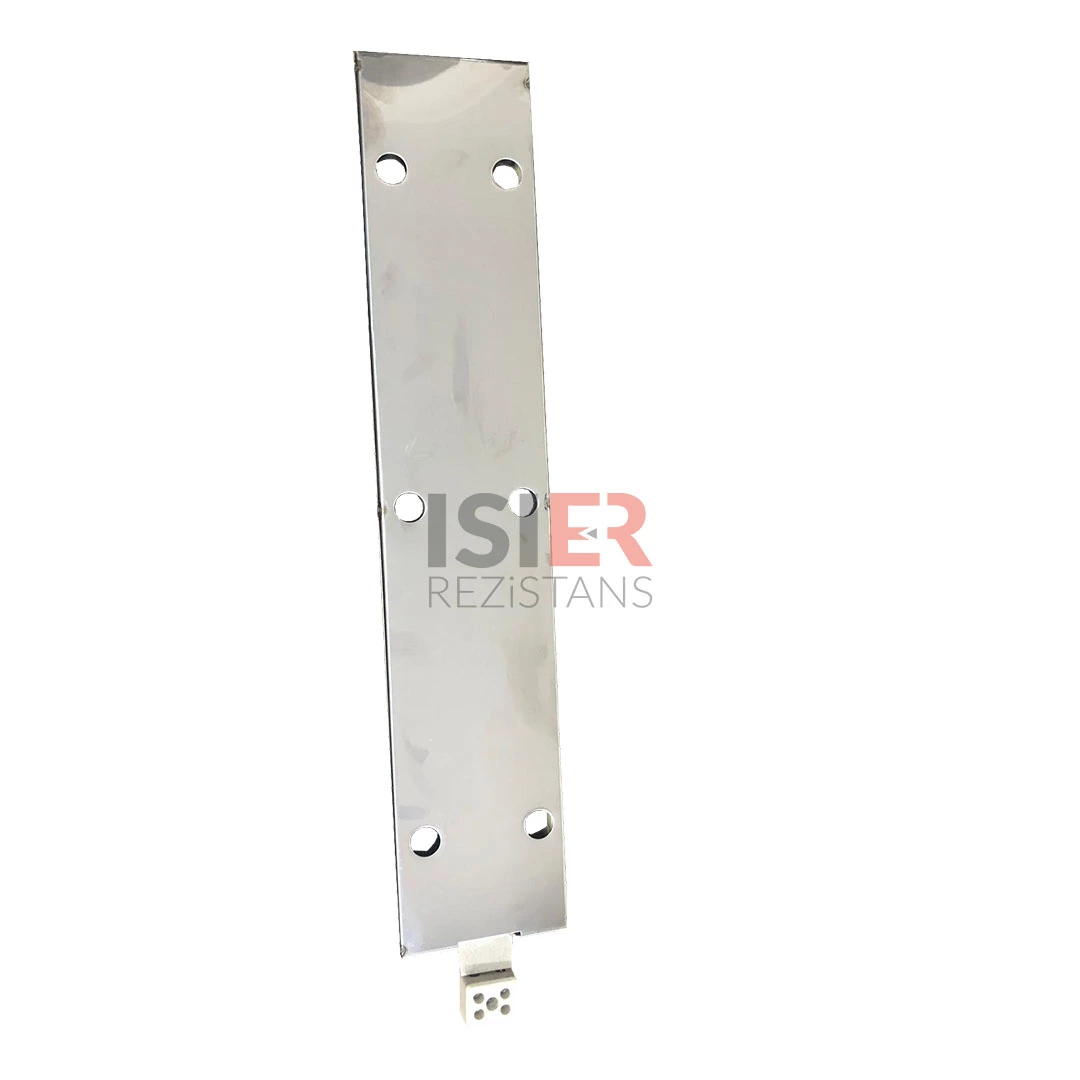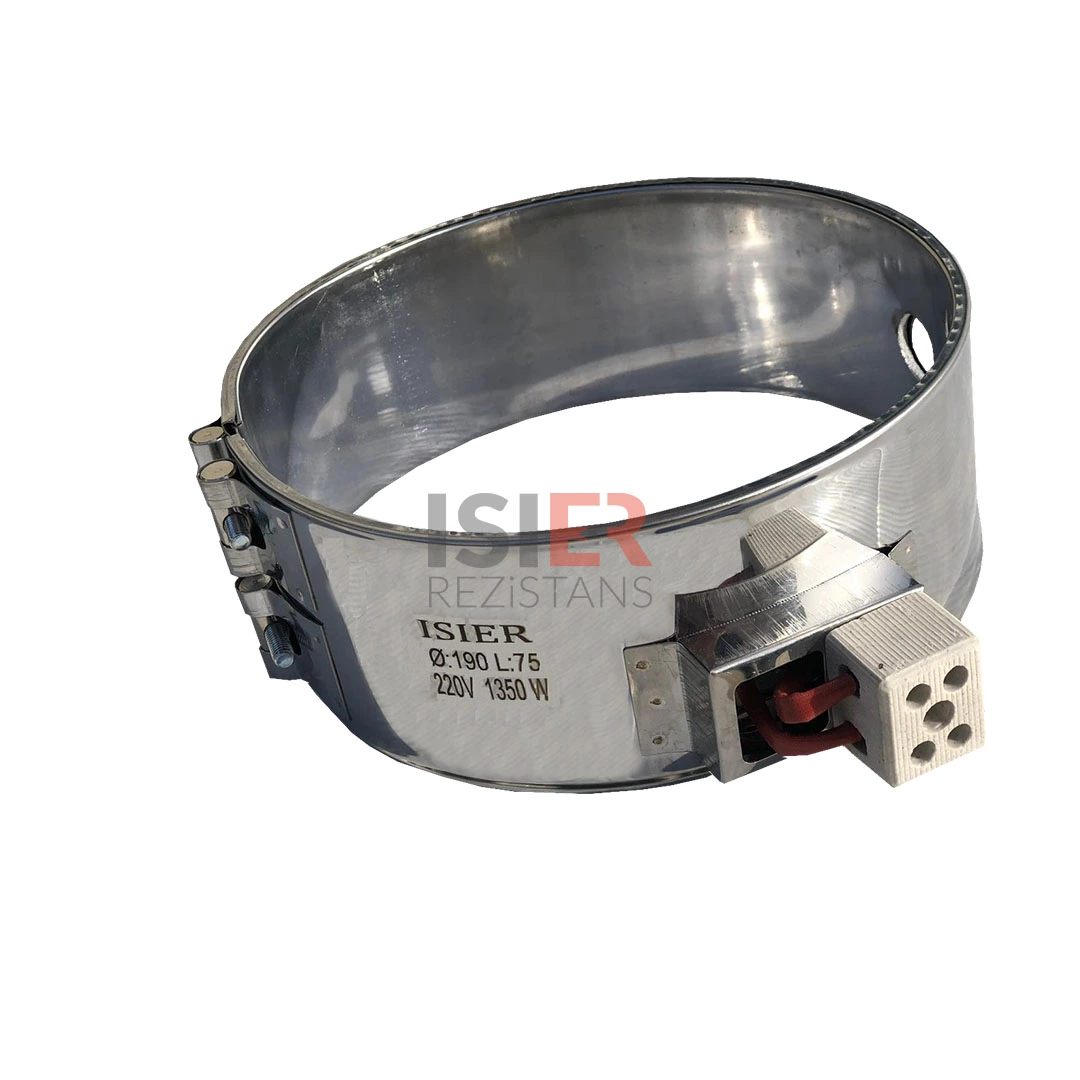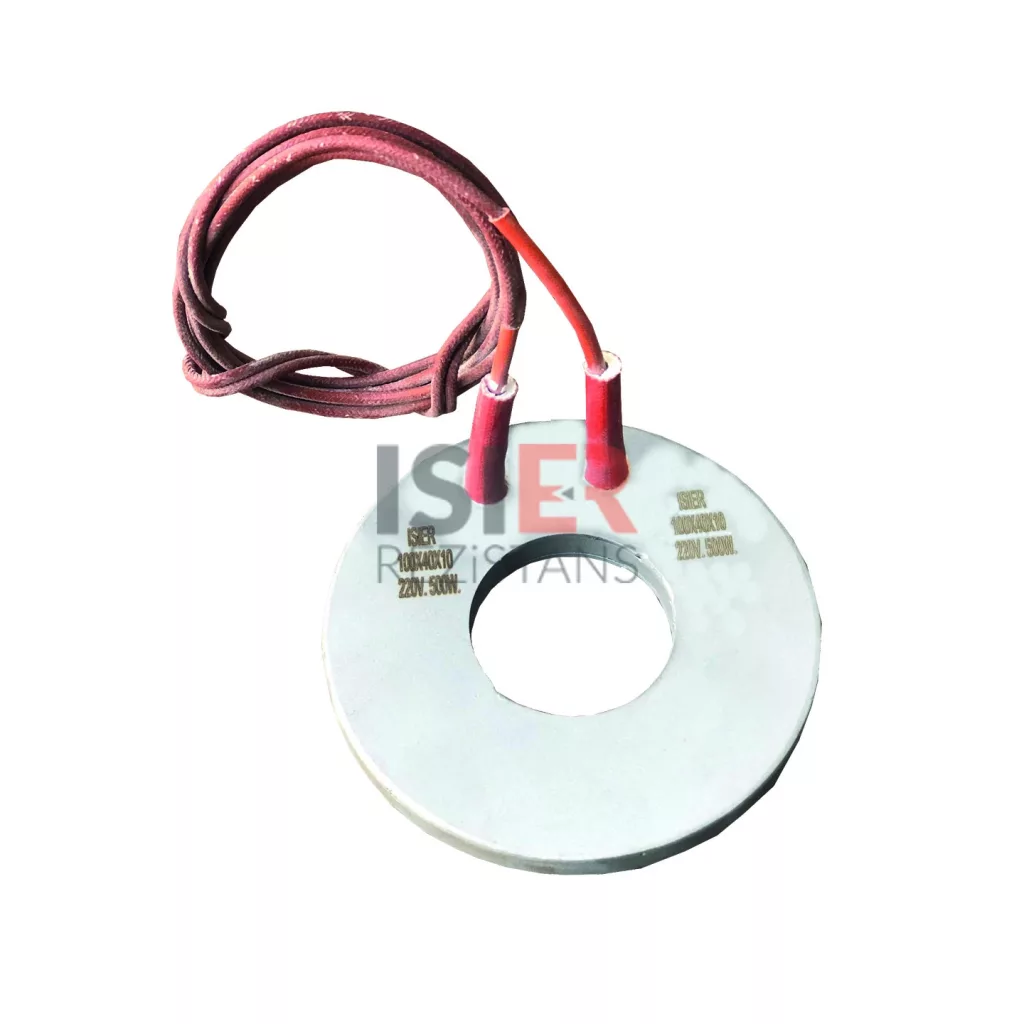Mica Heaters
are frequently used in heating the presses of molds and are a widely preferred type of resistance in the plastic, rubber and packaging sectors. Plate Type Resistors, which can easily respond to problems that may occur in heat systems (automotive-sub-industry, rubber cutting molds, textile machines,injection machines in the industry, are resistances specially produced with the latest technology from high efficiency 60/15 chrome nickel wire stainless and copper plate.
Mica Heaters models are a widely preferred type of resistance in industrial heat systems. This type of resistance be preferred in auto industry, rubber cutting molds, textile area injection machines and many other sectors. Our plate resistors of quality, which can produce solutions to problems that may occur in machines, can be produced from high efficiency chrome nickel wires and stainless, copper plates.
The basic principle in such resistors is that plate type resistance transfer the heat formed on both surfaces perfectly and does not accumulate heat on it. In order to prevent heat accumulation, pressure sheets are usually used on the surface of the resistors.
Technical Information
These resistance models be produced in the dimensions and shapes desired by the customer. Some of them are like flat, round,L type, type U. In addition, such resistors be produced in such a way that there are many holes on the surface (Connection, etc.). Mica Heaters energy outputs be screwed, wired, Clemensed and iron plug output. Mica Heaters are produced by wrapping 60/80/20 chrome wire 800ºC high purity mica and coating stainless, brass or copper plate hair. Plate Resistance products are made with cable output, screw, static clamp or plug. Plate heaters up to cm²
3.5 watts in areas such as plastic injection and mold heating are manufactured according to demand in desired sizes and values. For those who want higher wattage, ceramic plate resistors are more efficient as they be up to 6 watts per cm². Optionally, the hair enclosure is covered.
Mica Heaters, whose thickness can be extended from 0.10 mm to 1.50 cm, are superiorly resistant to copretion (compression). These resistance models also stand out with their superior water and chemical resistance feature.
In our Mica Heaters manufacturing, our professional teams produce our resistors and carry out quality checks in line with their findings and recommendations.
What are Mica Heaters?
Mica Heaters (Mica Resistance) is a term used in electrical engineering. It refers to the resistance of a flat conductor or a plate used to calculate the electrical resistance in a circuit. In some cases, mica heaters can also denote the specific resistance of a material, which is a measure of its electrical resistance.
Technical Specifications of Mica Heaters
The technical specifications that determine the characteristics of Mica Heaters include:
Material type: The structure and electrical/mechanical properties of the material affect the mica heater.
Mica thickness: Mica heater varies linearly with the thickness of the mica.
Mica dimensions: Mica heater is also associated with dimensions such as width and length of the mica.
Temperature: Increase in temperature may lead to an increase in mica heater.
Frequency: Mica heater may also vary with changes in frequency.
Electrical resistance (Ohm): Mica heater represents the resistance through which electrical current can pass when a specific voltage is applied.
Electrical conductance (Siemens): Defined as the inverse of mica heater and represents the capacity of electrical current to pass through the mica.
Thermal resistance (°C/W): Represents the increase in temperature across the mica when a specific power is applied.
Frequency response (Hz): Represents the frequency response of mica heater to changes in frequency.
These data are important factors to consider in the design, production, and application of mica heaters.
Mica Heaters Areas of Use
The applications of Mica Heaters include:
Electric home appliances: Mica heaters are used in household appliances such as refrigerators, ovens, and washing machines.
Electronic devices: Mica heaters are used in electronic devices like phones, tablets, and computers to control electrical currents.
Industrial equipment: In industrial machinery, mica heaters are used in communication, control, and power circuits.
Energy generation and distribution: Mica heaters are utilized in energy generation and distribution systems such as wind turbines, hydroelectric power plants, and supercapacitors.
Transportation and aviation: Mica heaters find applications in transportation and aviation systems including automobiles, airplanes, and trains.
Types of Mica Heaters
Various types of Mica Heaters can be produced for different materials and applications. The following types of mica heaters can be found:
Aluminum mica heaters: Aluminum mica heaters have a wide range of applications due to their lightweight, good conductivity, and affordability.
Nickel-chromium mica heaters: Nickel-chromium mica heaters are used in industrial applications due to their stability at high temperatures, good mechanical strength, and high resistance.
Cable-connected mica heaters: These types of mica heaters are used for the distribution of electrical signals in various applications.
Foil mica heaters: Foil mica heaters are used in electronic devices and computer equipment due to their lightweight, flexibility, and thinness.
Film mica heaters: Film mica heaters are used in high-frequency electronic systems, particularly due to their thin and lightweight construction.
The selection of mica heaters should be based on the specific requirements of the application.
Mica Heaters
Mica heaters are a type of electric resistance used for heating purposes. They consist of a resistance wire wound around an insulating material between two parallel mica plates. Mica heaters are typically manufactured by casting or pressing metal. When an electric current is applied to the resistance wire between the plates, the wire heats up and transfers heat to the surroundings with the assistance of the insulating material between the plates.
Mica heaters can be produced in different sizes and shapes and can be used in various heating applications. For example, they are used in many fields such as industrial ovens, heating units, and temperature control systems.
Mica Heaters Areas of Use
Mica heaters are used for heating purposes in various industrial and commercial applications, particularly in the following areas:
Industrial Ovens: Mica heaters are utilized in industrial ovens for baking, drying, or heating materials.
Food Industry: Mica heaters are employed in restaurants, buffets, and food production facilities for heating and holding food and beverages.
Plastic and Rubber Industry: Mica heaters are used in extruders and molding machines for melting and shaping plastic and rubber materials.
Packaging Industry: Mica heaters are used for heating and shaping plastic films and coating materials.
Chemical Industry: Mica heaters can be used for conducting chemical reactions or heating chemical substances.
Electronics Industry: Mica heaters can serve as heating elements in processes such as soldering and circuit production.
Technical Specifications of Mica Heaters
Material: The material used in the construction of mica heaters is typically aluminum or stainless steel, which have high thermal conductivity. These materials ensure resistance to high temperatures and longevity.
Dimensions: The dimensions of mica heaters can vary from manufacturer to manufacturer and from model to model. They typically have length, width, and thickness measurements. These dimensions may vary depending on the application area and the area to be heated.
Power: The power of mica heaters is determined based on the area to be heated and is usually expressed in watts. The maximum power that the heater can provide is specified by the manufacturer and is often found in the user manual.
Voltage: The operating voltage of mica heaters depends on the power source supplying the electrical energy. It is typically expressed in volts. The compatible voltage range for the heater is specified by the manufacturer.
Heat Distribution: Heat distribution on the surface of mica heaters is important. Good heat distribution provides uniform heating, allowing for faster and more consistent attainment of desired temperature values.
Mounting Options: Mica heaters are usually mounted by screwing onto a fixed surface or by using clips. Mounting options may vary depending on the environment and application.
Protection Features: Some models of mica heaters may be equipped with protection features such as internal thermal cutouts or thermistors to prevent overheating. These features enhance safety and prevent damage to the heater in case of overheating.
Waterproofing: Some models of mica heaters may have waterproof properties. These properties are important, especially for outdoor or humid environments, and ensure the longevity of the heater.
These technical specifications provide information about the design, performance, and application areas of mica heaters, aiding in making the right selection.
The Importance of Mica Heaters
Mica heaters are an important electrical heating element that meets heating requirements efficiently. The importance of these elements can be evaluated from several perspectives:
1. High Efficiency: Mica heaters operate with high efficiency by directly converting electrical energy into heat. This enables rapid attainment of desired temperatures while minimizing energy loss.
2. Precise Control: Mica heaters can be integrated with thermostats or other control systems to provide precise temperature control. This ensures continuous maintenance of desired temperature levels in various industrial and commercial applications.
3. Versatility: Mica heaters are available in different sizes, shapes, and power capacities. This diversity provides solutions suitable for various application areas, catering to different requirements.
4. Durability: High-quality mica heaters are typically made from materials with high temperature resistance. This offers a long-lasting and durable heating solution.
5. Flexibility: Mica heaters are a flexible heating solution that can be used in a wide range of industrial processes and applications. They can be utilized across various industries, from the food industry to the chemical industry.
6. Safety: When properly designed and installed, mica heaters operate safely. Isolated mounting and appropriate protective measures minimize the risk of fire or other safety hazards.
In conclusion, mica heaters play a significant role in industrial and commercial heating applications. With features such as high efficiency, precise control, durability, and safety, they provide businesses with a reliable and effective heating solution.









